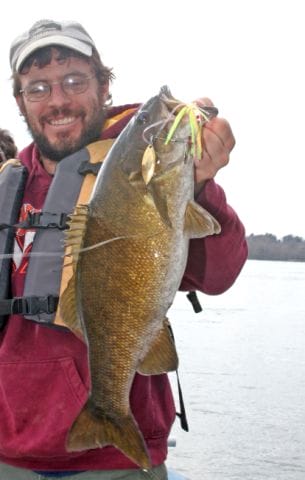by David Hart
The lure stopped dead just two turns of the reel handle into the retrieve. It’s almost impossible to hang a spinnerbait on a rock or log, but there I was, snagged just a few casts into the day.
The snag, however, pulled back. I snapped the rod tip upward and started cranking the reel handle as fast as I could. After a brief give-and-take, Shawn Hash scooped the smallmouth bass into a net, removed the spinnerbait from the corner of its mouth and gently laid the fish across a tape measure.
“Twenty-one inches,” proclaimed Hash, a New River, Virginia guide and owner of Tangent Outfitters.
It wasn’t just the first smallmouth of the day, it turned out to be the biggest bass of the day, my biggest in a couple of years and a true trophy in any smallmouth river. We ended up with a dozen or more over 17 inches, a great day considering it was mid-March, the water was in the mid-40s and the air only slightly warmer. Even better, there wasn’t another soul on the river.
It isn’t just the New River that holds so much promise in late winter and early spring. Smallmouth rivers everywhere, from the Pennsylvania’s Susquehanna to the John Day in Oregon, offer an honest shot at your biggest river smallmouth of the year. They may be a valley, a state or even a continent apart, but the fish are the same, especially the largest ones. Warming trends pull them out of their winter slumber and they eagerly scarf up minnows and crawfish and lures that imitate them.
“People always call my shop and ask what the water temperature is, but that’s not what’s important. I want to see an upward trend, no matter what the actual temperature is,” says Hash.
He admits that smallmouths are difficult to catch when the water dips below the 40s, but as soon as it ticks upwards a degree or two, he’s heading to the river. Any spike, whether from 39 to 42 or 50 to 52, is enough to stir winter-weary smallmouths and get them active.
He prefers the last day of an early spring warming trend, ideally one that lasts three or four days. Hash will schedule an outing for the third day. He also thinks an impending cold front stirs the feeding impulse, as well. Whatever the reason, Hash will be throwing just a handful of lures to a variety of locations.
He relies on crankbaits, spinnerbaits, hard jerkbaits and jigs and tubes this time of year. They may not all work on any given day, but a lifetime of chasing smallmouths has taught him that at least one will coax late-winter bass into his raft. What works sometimes depends on the water temperature, but not always. Fast-moving baits have worked on the coldest days and jigs and tubes will catch bass right through the blistering heat of summer.

Look for late-winter smallmouths in slower pockets along the shoreline and behind fallen trees and mid-river ledges and boulders.
A warming trend doesn’t just nudge big bass into biting, it can pull them out of deep, slow holes and onto shallower flats, particularly on sunny days. That’s because the bottom tends to warm a bit more and various bait like minnows and crawfish become more active over those warmer flats. Hash has caught trophy-sized smallmouths in as little as two feet of water on mild late-winter days. He’s also caught them in as much as 30 feet.
“You have to spend some time searching until you figure them out. I’ll work a variety of depths with a variety of lures until I start catching fish,” he says.
Patterns can hold up throughout a warming trend, but they can also change, even over the course of a day. If shallow flats stop producing, don’t assume the fish aren’t interested in eating anymore. Work deeper water or try a different lure or retrieve. Jerkbaits in particular can produce lots of fish, but smallmouths tend to favor a specific retrieve on certain days. They might like a steady, quick jerking retrieve or they may react better to longer pauses, up to three or four seconds. Try a variety of retrieves, colors and locations with other lures, as well.
Most fish tend to hold in pockets of slower water near current. They also seem to favor current breaks near the river’s banks, but Hash has caught plenty of quality smallmouths in deeper water below mid-river riffles and ledges.
No matter what you throw or where you throw it, just be prepared to set the hook, even when you think you are snagged on a rock or log. It could be the biggest smallmouth of your life.
For more information on early season smallmouth fishing, visit Shawn Hash and Tangent Outfitters website at www.newrivertrail.com.
The Union Sportsmen’s Alliance website is designed to provide valuable articles about hunting, fishing and conservation for members of AFL-CIO affiliated labor unions and all sportsmen and sportswomen who appreciate hunting and fishing and want to preserve our outdoor heritage for future generations. If you would like your own story and experience from the outdoors to be considered for our website, please email us at [email protected].








